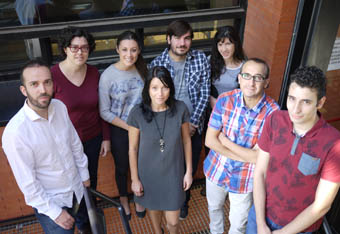
A research by the Cavanilles Institute of Biodiversity and Evolutionary Biology of the Universitat de València, led by professor Rafael Sanjuán, reveals that some virus infect the cells in group, which allows them to establish relations with each other and help each other to attack better. The results of the work will be published today in the journal ‘Cell Host &Microbe’.
Considered the cell variation, scientists think it is essential to understand virus genetic structure at the level of single cells . Because of this, researchers of Universitat de València have combined cell isolation techniques with other of ultra-deep sequencing. “We have characterised the genetic structure and the RNA diversity of the virus and we show that the individual infectious units are constituted by genetically multiple viral genomes”, explains Rafael Sanjuán. Moreover, the conclusions of this research show that viral particles “interact functionally”, adds the professor.
Rafael Sanjuán emphasises that the rate of spontaneous viral mutation changes depending on single cells, while the early production of diversity depends on the viral generation from the first moment of the infection of the cell.
This way, the results of this study show that natural selection “facilitates the functioning of the group of virus in relation to its position in the same cell”, according to Sanjuán, who recalls that his work discovers “genetic and structural features of the virus at an individual level, but with implications for evolution and viral diversity”.
To a better understanding of infections
Traditionally, virologists have tried to purify virus by means of the isolation of single cells, however the results of this research show that this approach “is not necessarily valid because it ignores the social dimension of the virus”, as Sanjuán said. Social interactions between virus were discovered some years ago and they have changed the perception of these microbes. At the same time, this study -together with others recently published- proves evidence that virus establish interactions that are potentially important to better understand and fight these infections caused by these agents.
Rafael Sanjuán is associate professor at the Department of Genetics of Universitat de València and researcher in the Evolution and Health team at Cavanilles Institute of Biodiversity and Evolutionary Biology of Universitat de València. The research of this team focus on the study of the mechanisms responsible for the creation and maintenance of genetic variation in virus like HIV or hepatitis A. Sanjuán is currently the principal investigator of three national and international research projects and he has published more than 60 research works about evolution and virus in the last 10 years.
Marine Combe, Raquel Garijo, Ron Geller, José M. Cuevas, Rafael Sanjuán. 2015. ‘Single-Cell Analysis of RNA Virus Infection Identifies Multiple Genetically Diverse Viral Genomes within Single Infectious Units’. ‘Host Cell & Microbe’
Last update: 15 de october de 2015 10:46.
News release



















